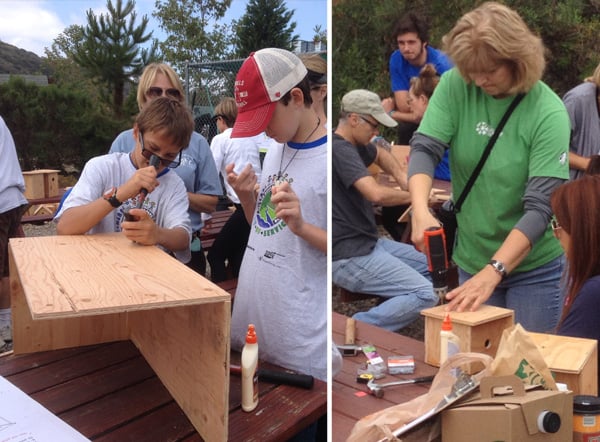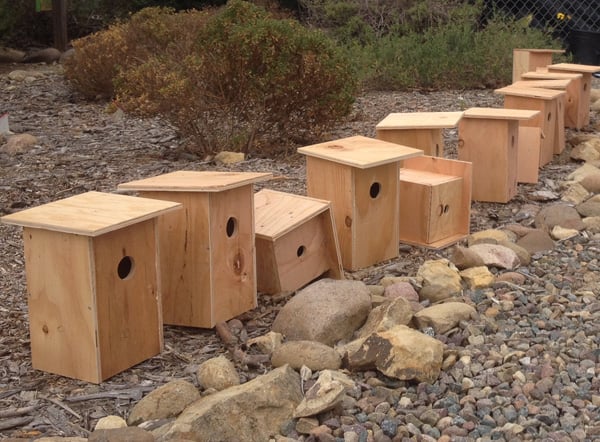Each Earth Day Valley Box looks for environmentally sustainable ways to give back to the San Diego community. In years past we've planted trees along the San Diego River. This year we wanted to do something different. It just so happened that during a Lean Manufacturing meeting focusing on waste reduction the Valley Box team had started discussing ideas for using the scrap plywood that would otherwise be destined for recycling at Waste Management.
Alicia Guillette, Vice President at Valley Box, called up our friends at the San Diego River Park Foundation. An organization of people who champion the creation of a river park system that celebrates the San Diego River's unique natural and cultural legacy while providing the community with recreational activities and a greater connection to nature.
 |
 |
Valley Box and SDRPF started discussing ideas for donating the scrap plywood in a way that would better the community, and the idea of bird houses were mentioned. SDRPF did some research on the matter and it turned out there was a huge demand for bird sanctuaries along the 52 miles of the San Diego River! SDRPF was in the midst of planning their annual San Diego River Days Youth Day of Service event, and felt the addition of bird house building was a fantastic fit!
Valley Box worked closely with SDRPF to find designs that would be suitable for local species of birds. We settled on houses designed to fit owls, blue birds, wrens and even bats! We then had our engineers draw up the plans and cutting schedules while keeping several key points in mind.

|
Entrance hole size The size of the hole is very important in that the purpose is to keep out predators and more aggressive non-native birds. Nontoxic materials The best birdhouses are not finished with toxic paints or stains. Natural wood is the best choice for preventing the birds from having contact with anything toxic. Floor size Birds need a certain amount of floor space inside the house so the hatchlings have room to grow. For smaller birds like wrens, 4" x 4" is usually fine. Larger birds, like owls, need more floor space. Entrance height This is measured from the floor of the box to the bottom of the entrance hole, and this distance is important for keeping eggs and hatchlings out of reach of predators that may approach the hole and try to scoop inside the house. Roof overhang An inch or two of roof overhang will keep rain from entering the birdhouse entrance hole and will also help shade the interior on hot days. Perch-free entrance Perches may look cute, but they simply give predators something to hold onto when approaching the entrance hole. Since natural cavities such as tree trunks do not have perches, birds that will use nest boxes don't need a perch either. One side that opens Birdhouses that you can be opened can be kept more sanitary because you can access the inside more easily for clean out. |

Valley Box wanted to make the assembly of each house easy to follow and understand. After a few test assemblies step-by-step instructions were written and printed out onto big displays for the volunteers to follow. The pieces of plywood were labeled and kept separate in planter buckets (borrowed from the SDRPF shed). Each table was provided with the hammer, wood glue, small tape measure and nails required to build a bird house.

The day of the event was so much fun. SDRPF organized and provided all the tools necessary for 50+ volunteers, parents kids & teens, to rotate in large groups between stations every hour. Stations consisted of; painting trail markers, planting native plants and bird house building. On the day of the event several Valley Box employees donated their time to help the volunteers assemble their bird houses.

Volunteers dug in and got down to assembling houses. No matter what building experience the volunteer was at they all had a great time. Young kids and their parents worked diligently to assemble each bird house. Some young boys were able to make several houses in the hour they were at the bird house station!

As more habitats become threatened through development, these bird houses will be a safe place in which local and migratory birds can take refuge from natural predators, raise their young, and remain healthy. The houses will act as a critical oasis for bird conservation and preserve birds in the larger local environment.
Later the houses will be hung in trees and affixed to poles along the San Diego River to provide homes for many species of birds. Pole mounts are one of the ways to deter predators because predators have a more difficult time climbing a thin pole than a tree trunk.
If you're interested in helping out there are many ways to get involved with the San Diego River Park Foundation, learn more using the links below:



